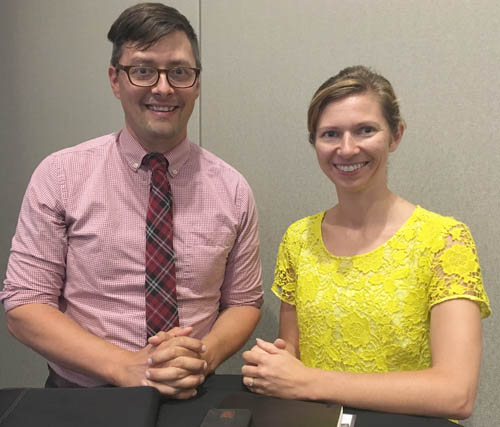 Like most people, Tara Brown experiences the increasing frequency and impact of severe weather in the Twin Cities, signals of a changing climate.
Like most people, Tara Brown experiences the increasing frequency and impact of severe weather in the Twin Cities, signals of a changing climate.
She’s also in a rare position to help guide her city’s response to the changes.
Brown, Sustainability Coordinator for the City of Edina, is among many local government professionals on the leading edge of addressing climate change. Working within the city and with its partners—including the Metropolitan Council—she and other public servants are planning to prepare communities for the inevitable challenges ahead.
“Climate change is one of the greatest challenges of our time, and it’s happening right now,” Brown said.
“We can do a lot to mitigate the worst impacts. That’s what interests me and motivates me to help my community prepare. It’s an exciting project to work on, to influence our local response and help us adapt to the changing climate.”
Council a key partner in improving community resiliency
 Many cities have already begun planning for climate change, and subregional groups are cropping up to leverage resources. The Council is assessing its own infrastructure, identifying vulnerabilities to flooding and extreme heat, and making contingency plans.
Many cities have already begun planning for climate change, and subregional groups are cropping up to leverage resources. The Council is assessing its own infrastructure, identifying vulnerabilities to flooding and extreme heat, and making contingency plans.
Brown joined other like-minded professionals early this year at a workshop series designed to help local government staff in the southwest metro prepare for the impacts of climate change.
Hosted by the Freshwater Society and cosponsored by the Council, the “Community Resilience Building Workshops” drew staff from cities, state government, watershed districts, and consulting engineers as well as community residents.
Council Senior Planner Eric Wojchik said the Council is encouraging cities to plan for climate change as part of their next long-range comprehensive plan update.
The Council sponsors a series of planning workshops to help cities prepare their local comprehensive plan updates due in 2018; some events were dedicated to community resilience.
 “Going back to the Council’s earliest days, our job has been helping local governments prepare for future growth and to coordinate development across jurisdictions with the entire region in mind,” Wojchik said.
“Going back to the Council’s earliest days, our job has been helping local governments prepare for future growth and to coordinate development across jurisdictions with the entire region in mind,” Wojchik said.
“In 1967, no one could have predicted that our region would be facing the challenges presented by climate change. But like other past regionwide issues – water pollution, water supply, transportation systems – climate change cuts across all jurisdictions and threatens our economic stability, livability and sustainability.
“This is critical work to preserve the region’s well-being and prosperity over the long-term,” he said.
Planners look ahead at vulnerabilities, prioritize responses for each
In the Freshwater Society workshops, participants looked at climate impacts in three major areas:
-
Society (residents, first responders, schools and hospitals)
-
Environment (lakes, wetlands, forests)
-
Infrastructure (roads, bridges, sewers, water supply)
 Participants identified their chief concerns in the near-term: climate impacts associated with warmer winters, extreme heat, strong storms and wind, and extreme precipitation.
Participants identified their chief concerns in the near-term: climate impacts associated with warmer winters, extreme heat, strong storms and wind, and extreme precipitation.
After assessing each city’s vulnerabilities—for example flooding, a water supply shortage, failed infrastructure—participants began developing policies and strategies to address each possible outcome.
In Edina, city staff developed a list of nearly two dozen recommendations to boost the community’s resilience, or its ability to thrive in the wake of a climate impact. A few top-ranked priorities were:
-
Create emergency plans for facilities for the elderly, including alternative power sources and evacuation plans.
-
Create emergency plans for schools and daycares.
-
Manage street flooding during extreme rain events, but plan for emergency vehicles to pass.
-
Increase the urban forest to mitigate the heat island effect and heat waves.
For each city, these efforts will eventually encompass several rounds of public input at key points along the way. Public input will be interspersed with strategic planning, including input from the city’s police and fire departments, public works, natural resources and parks staff, and others.
Ultimately, community resilience planning at the local level will need a stamp of approval by local elected officials before it becomes part of the city’s official local comprehensive plan.
Community Resilience planning
Not planning is not an option
It’s going to be a long road, but not planning is not an option, said Lisa Barajas, the Council’s Local Planning Assistance Manager, whose department oversees the comprehensive plan update process.
“Community resiliency is having the capacity to respond, adapt, and thrive under changing conditions, and that’s exactly the roadmap we’re taking to help the region prepare for the unknowns ahead. Collectively, the region has a lot of knowledge already, and we need to build on that base for everyone to share.
“Fortunately, many communities already include elements of resiliency in their comprehensive plans, and in actions they’ve already undertaken. In the decades ahead there will be a lot at stake in terms of the health and prosperity of our residents, our communities and the entire region.”

Get involved
Contact your city or county to see what plans they are making to ensure resilience against extreme weather and other effects of climate change.